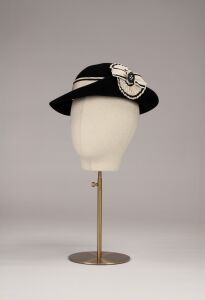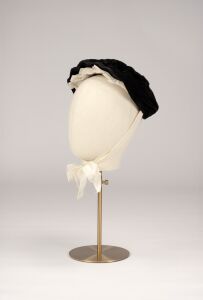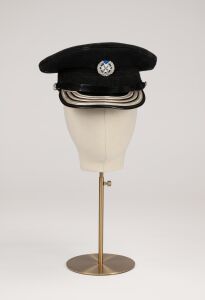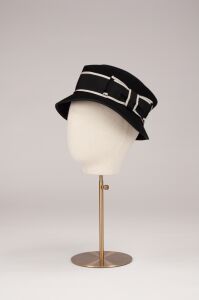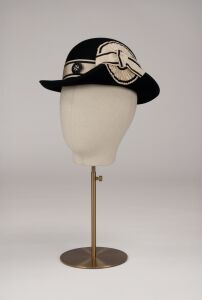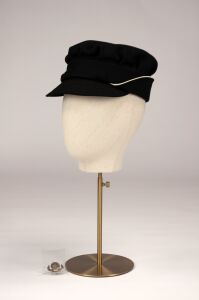As women gained recognition in public spheres, nursing uniforms became powerful sartorial tools for navigating the complex interplay of gender, labour, and power. Hats, in particular, help trace this embodied history of the nursing profession as it transitioned from a feminine duty to care to a symbol of national identity.
In the mid-1890s, the Order of St John established the Home Nursing & Midwifery branch. At the time, nursing was among the few respectable professions for women, aligned with Victorian ideals of women's philanthropic nature. Nurses, known for their charitable work, were expected to embody selflessness, like the Nursing Sisters who distributed clothing to poor children in Clerkenwell: “If one looked for weariness on the part of the good Sisters engaged in their labour of love, it was not apparent, each one seemed too engrossed in the work on hand to give even a thought to one’s self.” This obligation to care was rooted in gendered assumptions that women are naturally suited for nurturing roles.
Initially, voluntary nurses wore uniforms similar to those of Nightingale-era professionals: black dresses, white aprons, and Sister Dora bonnets. However, as the profession evolved, the impracticality of these hyper-feminine uniforms became apparent: “Why – in the name of common sense – put the nurses into a uniform which is an absolute hindrance to them in their work? I refer to the long cumbersome flowing cloak, and the unsuitable bonnet with strings…We could see how hampered the nurses were who wore this uniform when they had to stoop and kneel by the side of a patient.” As medical practices advanced, uniforms became more functional, increasingly resembling those worn by their male counterparts.
During and after the Second World War, recruitment campaigns framed nursing as a civic duty. As women became more involved in national service, their uniforms adopted more militarised designs. The Order of St John instituted regular uniform inspections, similar to military protocols, which helped distinguish members from the public and fostered a sense of collective purpose and discipline, revealing the use of uniforms as a regulatory tool of the disciplinary state.
The evolution of the nursing uniform reflects broader changes in women's societal roles. Hats, in particular, embody the gendered politics of power, as headgear historically indicates rank and authority. The following section delves into the hats from the Museum of the Order of St John's uniform collection as material embodiments of this gendered history.
This theme was researched and written by Madison Hough as part of the Costume Society's Museum Work Experience Grant 2024.
In the mid-1890s, the Order of St John established the Home Nursing & Midwifery branch. At the time, nursing was among the few respectable professions for women, aligned with Victorian ideals of women's philanthropic nature. Nurses, known for their charitable work, were expected to embody selflessness, like the Nursing Sisters who distributed clothing to poor children in Clerkenwell: “If one looked for weariness on the part of the good Sisters engaged in their labour of love, it was not apparent, each one seemed too engrossed in the work on hand to give even a thought to one’s self.” This obligation to care was rooted in gendered assumptions that women are naturally suited for nurturing roles.
Initially, voluntary nurses wore uniforms similar to those of Nightingale-era professionals: black dresses, white aprons, and Sister Dora bonnets. However, as the profession evolved, the impracticality of these hyper-feminine uniforms became apparent: “Why – in the name of common sense – put the nurses into a uniform which is an absolute hindrance to them in their work? I refer to the long cumbersome flowing cloak, and the unsuitable bonnet with strings…We could see how hampered the nurses were who wore this uniform when they had to stoop and kneel by the side of a patient.” As medical practices advanced, uniforms became more functional, increasingly resembling those worn by their male counterparts.
During and after the Second World War, recruitment campaigns framed nursing as a civic duty. As women became more involved in national service, their uniforms adopted more militarised designs. The Order of St John instituted regular uniform inspections, similar to military protocols, which helped distinguish members from the public and fostered a sense of collective purpose and discipline, revealing the use of uniforms as a regulatory tool of the disciplinary state.
The evolution of the nursing uniform reflects broader changes in women's societal roles. Hats, in particular, embody the gendered politics of power, as headgear historically indicates rank and authority. The following section delves into the hats from the Museum of the Order of St John's uniform collection as material embodiments of this gendered history.
This theme was researched and written by Madison Hough as part of the Costume Society's Museum Work Experience Grant 2024.

